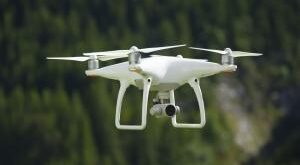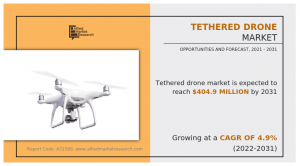(MENAFN- GlobeNewsWire – Nasdaq)
New York, Dec. 15, 2021 (GLOBE NEWSWIRE) — Reportlinker.com announces the release of the report ‘Anti-drone Market – Growth, Trends, COVID-19 Impact, and Forecasts (2021 – 2026)’ –
However, according to the Stockholm International Peace Research Institute (SIPRI), global military spending increased by 2.6% to reach USD 1,981 billion in 2020. Nevertheless, defense spending may slightly decline in the future, due to the global economic crisis triggered by the pandemic. This factor is expected to challenge the growth of the anti-drone market during the forecast period.
The demand for anti-drone systems is primarily due to the growing use of drones in different applications. Incidents of security breaches by unidentified drones and the use of drones by terrorist groups are further propelling the demand for counter-drone technologies. Apart from the defense sector, the counter-drone systems are also being procured by homeland securities and law enforcement agencies to counter unidentified drones entering critical infrastructures.
Counter-drone systems come with their set of challenges at the level of performance, practicality, legality, and policy. The use of anti-drone jammers or unauthorized UAS detection and countermeasure deployments can result in electromagnetic and radio frequency (RF) interference, especially at airports, which can affect the safety of flight and air traffic management issues. These limitations are expected to challenge the growth of the market during the forecast period.
Key Market Trends
Military Segment Held the Largest Market Share in 2020
The military segment of the market accounted for a major share of the revenues in 2020. This is due to the increase in the use of drones by adversaries and insurgent groups for spying and attacking military infrastructure and borders. Such incidents have necessitated the R&D of sophisticated C-UASs that can identify, track, and disable the drone and locate its operator simultaneously. Hence, several armed forces are now focusing on enhancing their counter-drone capabilities. In this regard, during FY 2021, the Japanese MoD allocated a USD 20 million budget toward the R&D of C-UAS technology. Additionally, the MoD made provisions worth USD 4.8 million to conduct research on microwaves that can be used in a C-UAV system. Likewise, in December 2020, the Indian Navy finalized a contract for procurement of a batch of counter-drone weapon systems capable of bringing down high-speed enemy drones. The delivery of the SMASH 2000 fire control systems, manufactured by the Israeli firm Smart Shooter was planned to begin in 2021. The SMASH 2000 is a combat-proven Fire Control System that can be installed in various types of small arms and can be used to shoot down enemy drones. Such developments are expected to drive market growth during the forecast period.
North America is Expected to Dominate the Market During the Forecast Period
North America held the largest market share in 2020, and the region is also expected to continue its dominance over the market during the forecast period. This is primarily due to the increasing investments of the US Department of Defense (DoD) into the development and deployment of counter-drone systems. For instance, during FY 2022, the US DoD plans to spend at least USD 636 million on the R&D of C-UAV systems and around USD 75 million on the procurement of such systems. Also, in April 2021, the US Air Force released a request for proposals for the rapid research, development, prototyping, demonstration, evaluation, and transition of technologies that can be used to counter small unmanned aerial systems. By the end of 2021, the US Air Force may award the counter-UAV contract worth up to USD 490 million to provide the technologies to counter the threat of small, commercially made drones. The period of performance for the contract is 72 months. On the other hand, illegitimate drone incursions at the airports and other critical infrastructure can result in safety issues, and they have raised concerns over the years, across several such sites in the United States and Canada. With the advancement in technology, many counter-drone systems are expected to be installed by the various end users in the region to protect their critical infrastructure and assets of strategic importance over the coming years, which is also expected to drive the growth of the market in the region in the future.
Competitive Landscape
Some of the prominent players in the anti-drone market are Raytheon Technologies Corporation, Lockheed Martin Corporation, QinetiQ Group PLC, Thales Group, and SAAB AB. Several start-ups are also entering the market with innovative products, which are further increasing the competition in the market. The proliferation of local players is also increasing in the market, supplying various types of anti-drone solutions. On this note, in August 2021, the Turkish company Meteksan Defence has presented an upgraded version of its Kapan counter-drone system at the IDEF 2021. The system features a new version of the Retinar FAR-AD Drone Detection Radar with a new antenna tailored for precise detection of mini/micro unmanned aerial vehicles (UAVs), high-performance hardware, and specific algorithms supported by artificial intelligence technologies. These developments, which will likely benefit industry stakeholders during the forecast period. Several companies are focused on developing counter-drone technologies that can be useful for the global militaries, which can fetch long-term contracts and help the companies to expand their market share in the coming years. For instance, in May 2021, Leonardo Electronics US unveiled the Falcon Shield Counter UAV System for the US DoD, DOE, Border Patrol, and partners. The system addresses the threat of low, slow, and small unmanned air systems undetectable by conventional air surveillance equipment. With the growing investments in new products and the increasing demand from the defense and commercial sector, the anti-drone market is highly lucrative. This is likely to offer new opportunities for the existing and new players in the future.
Additional Benefits:
The market estimate (ME) sheet in Excel format
3 months of analyst support
Read the full report:
About Reportlinker
ReportLinker is an award-winning market research solution. Reportlinker finds and organizes the latest industry data so you get all the market research you need – instantly, in one place.
__________________________
MENAFN15122021004107003653ID1103366736
Legal Disclaimer: MENAFN provides the information “as is” without warranty of any kind. We do not accept any responsibility or liability for the accuracy, content, images, videos, licenses, completeness, legality, or reliability of the information contained in this article. If you have any complaints or copyright issues related to this article, kindly contact the provider above.
 Unmanned Aerial Vehicle The latest drone news
Unmanned Aerial Vehicle The latest drone news




